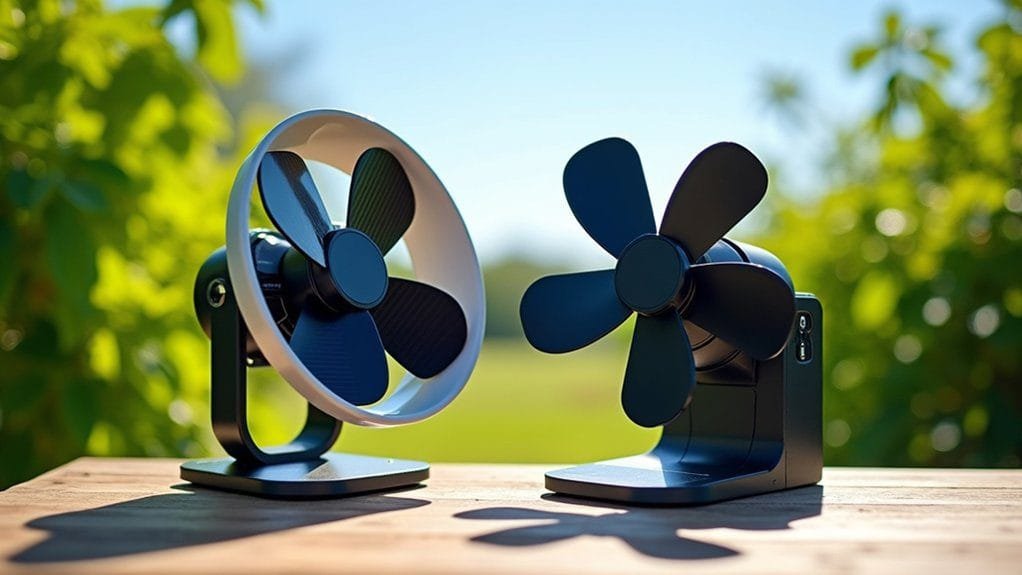Solar fans are your eco-friendly cooling solution, converting 15-20% of sunlight into electricity with zero emissions. You’ll reduce your carbon footprint compared to battery-powered alternatives that generate substantial waste and rely on non-renewable energy sources. While solar fans have higher upfront costs, they offer long-term savings and sustainable performance over 20-25 years. Curious about how solar technology can transform your cooling strategy?
Key Takeaways
- Solar fans produce zero direct emissions and utilize renewable energy, significantly reducing environmental impact compared to battery-powered alternatives.
- Battery fans generate substantial electronic waste through frequent battery replacements, while solar fans have minimal waste and longer panel lifespans (20-25 years).
- Solar technology converts 15%-20% of solar energy into electricity, offering a clean energy solution that supports carbon footprint reduction.
- Battery fans rely on non-renewable charging sources and have declining efficiency over time, making them less environmentally sustainable than solar fans.
- Solar fans support clean energy technologies and provide long-term ecological benefits by leveraging renewable solar resources with minimal operational environmental consequences.
Understanding Solar and Battery-Powered Fans


Although solar and battery-powered fans might seem similar at first glance, they operate through distinctly different mechanisms. Solar-powered fans leverage photovoltaic panels to convert sunlight into electricity, enabling renewable energy consumption with minimal carbon emissions. These fans are particularly effective in environments with consistent sunlight, making them ideal for off-grid applications. Battery-powered fans, conversely, rely on rechargeable batteries that require periodic replacement and regular charging, which can impact long-term electricity bills. Their energy consumption patterns differ greatly, with solar fans drawing power directly from sunlight and battery fans dependent on stored electrical charge. Understanding these fundamental differences helps consumers evaluate the environmental impact and cost-effectiveness of each fan type, ultimately determining which technology aligns best with their specific cooling needs and sustainability goals.
Energy Efficiency Comparison
While energy efficiency stands as a critical factor in fan selection, solar and battery-powered fans demonstrate markedly different performance metrics. Solar fans convert 15%-20% of solar energy into electricity under ideal conditions, leveraging renewable energy with minimal ongoing expenses. By utilizing solar panels that maintain efficiency even in low-light environments, you’ll reduce utility bills and carbon footprint simultaneously.
Battery-powered fans, conversely, depend on rechargeable lithium-ion batteries with fluctuating performance characteristics. Their energy efficiency declines as battery health deteriorates, requiring frequent replacements that increase long-term operational costs. Additionally, these fans contribute to higher electricity consumption through repeated charging cycles, creating a less environmentally sustainable solution compared to solar alternatives that directly harness free solar energy.
Environmental Impact Assessment


As global environmental consciousness continues to rise, the ecological footprint of consumer electronics demands rigorous scrutiny, particularly in the domain of personal cooling solutions. Solar fans emerge as a compelling alternative to battery-powered fans, offering significant environmental advantages.
| Aspect | Solar Fans | Battery Fans |
|---|---|---|
| Emissions | Zero | High |
| Energy Source | Renewable | Non-renewable |
| Waste Generation | Minimal | Substantial |
| Operational Cost | Low | High |
| Environmental Impact | Clean | Polluting |
Your choice between solar and battery-powered fans directly influences electricity consumption and carbon emissions. Solar fans harness renewable energy, eliminating disposable battery waste and reducing e-waste. They operate silently, producing no harmful pollutants, while battery-powered fans contribute to resource depletion and environmental degradation. By selecting solar fans, you’re investing in a sustainable cooling solution that minimizes your carbon footprint and supports clean energy technologies.
Cost Analysis Over Time
Beyond environmental considerations, the financial implications of choosing between solar and battery-powered fans warrant extensive economic analysis. Solar fans present a higher initial cost but offer substantial long-term savings through free energy sources. You’ll find that while rechargeable battery fans seem cheaper upfront, their operational costs escalate with frequent battery replacements and electricity consumption.
The longevity of solar panels—spanning 20-25 years—significantly enhances the cost-effectiveness of solar fans. When calculating total expense, consider that solar technology reduces ongoing electricity expenditures and minimizes carbon emissions. Battery-powered fans, conversely, involve continuous monetary investments in energy and replacement components.
Ultimately, your choice between solar and battery-powered fans should prioritize not just immediate pricing, but thorough economic and environmental impact assessments.
Performance and Functionality Evaluation


When comparing solar and battery-powered fans, performance metrics reveal critical distinctions in operational efficiency and functionality. Solar powered fans leverage energy from the sun, delivering consistent airflow at 15-20% efficiency during ideal conditions, while battery-powered fans offer more versatile portability. Your outdoor use considerations will greatly impact fan selection, with solar fans excelling in sunny environments and battery models performing reliably across varied settings.
Performance evaluations highlight key differences: solar fans depend on sunlight intensity, potentially limiting airflow coverage, whereas battery-powered fans maintain consistent operation. Eco-friendly consumers will appreciate solar fans’ direct energy conversion, but should recognize their reduced reliability during cloudy periods. Ultimately, your choice hinges on understanding each technology’s strengths—solar fans’ sustainable design versus battery fans’ dependable functionality.
Practical Applications and Portability
Because portability and practical utility define fan selection, solar and battery-powered models present distinct advantages for consumers seeking mobile cooling solutions. Solar-powered fans excel in off-grid applications, relying on sunlight to provide continuous cooling during outdoor activities like camping and gardening without depending on an electrical outlet. Battery-powered fans offer greater versatility through compact designs and easy charging capabilities, making them ideal for travelers and users with intermittent power access. While solar fans require solar panel mounting, they deliver eco-friendly performance in remote environments. Battery-powered alternatives prioritize lightweight construction and universal usability across indoor and outdoor settings. Your choice ultimately depends on specific cooling needs, with solar fans optimizing sustainable energy utilization and battery models maximizing convenience and immediate operational flexibility.
Making the Sustainable Choice
As consumers increasingly prioritize environmentally responsible technologies, solar-powered fans emerge as a compelling sustainable cooling solution compared to traditional battery-powered alternatives. By harnessing renewable energy, solar fans effectively reduce carbon emissions and minimize electricity costs while providing an eco-friendly cooling option. The 15-20% efficiency of solar panels enables these devices to convert sunlight into electricity with minimal environmental impact, offering long-term savings and sustainable performance.
When evaluating cooling technologies, you’ll find solar fans present a significant advantage over battery-powered models. They eliminate recurring battery replacement expenses and leverage clean energy sources, directly contributing to reduced environmental footprint. Your choice of solar-powered fans represents a strategic investment in sustainability, transforming personal cooling needs into an opportunity for meaningful ecological engagement.
Frequently Asked Questions
What Are the Disadvantages of Solar Fans?
You’ll face solar fan limitations like high initial costs, weather dependency, and reduced performance on cloudy days. Installation challenges, battery lifespan concerns, and energy efficiency issues can make them less practical than traditional cooling solutions.
Are Solar Batteries Environmentally Friendly?
Solar batteries aren’t perfect, but they’re increasingly eco-friendly. You’ll find their renewable energy efficiency and sustainable power solutions considerably reduce carbon footprints, especially as solar technology advances and battery recycling improves lifecycle environmental impact.
Are Solar-Powered Fans Any Good?
Solar fans are effective if you prioritize efficiency and sustainability. Their performance varies, but advanced technology offers solid durability, portability, and cost-effectiveness. You’ll benefit from low maintenance, innovative design, and renewable energy usage in suitable environments.
Are Electric Fans Eco Friendly?
Ironically, your quest for cool comfort might heat up environmental debates. Electric fans’ eco-friendliness varies, depending on energy efficiency, power consumption, and local renewable resources—balancing personal cooling needs with sustainable materials and climate impact.
Conclusion
When choosing between solar and battery-powered fans, you’ll find solar emerges as the clear environmental victor. Like a navigator charting a sustainable course through energy consumption, solar fans harness renewable resources with minimal carbon footprint. Your decision impacts both personal comfort and ecological responsibility. Statistical evidence consistently demonstrates solar technology’s superior energy efficiency and long-term environmental benefits, making it the more eco-conscious choice for conscientious consumers.
